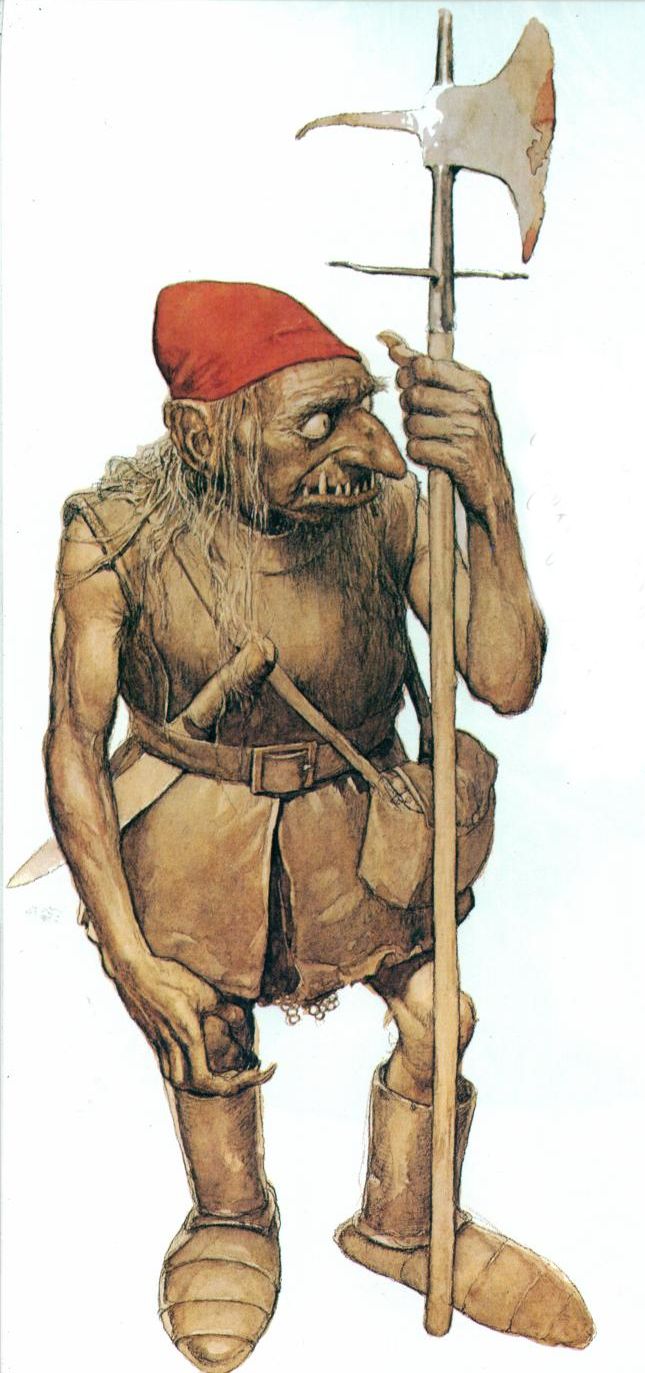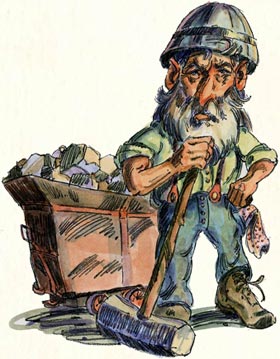I think Tolkien's take on elves lives on to some degree. He actively wanted to make them into powerful magical beings instead of the faerie-like creatures that he had seen them degenerate into in the English language tradition. This is partly reflected in D&D, although Poul Anderson also had variant takes on elves that were influential. But in some ways, Tolkien's The Hobbit did the opposite to goblins, making them more mundane, in a way that was reinforced and compounded by how they evolved after being adapted as a monster in D&D.
As D&D has grown there is something of a cursus honorum (the succession of magistracies that defined a Roman politician's career) of humanoids: kobolds, goblins, orcs, hobgoblins, and gnolls, rising from 1/2 HD to 2 HD. As I mentioned not long ago, even making kobolds into experts in guerrilla tactics has become a cliché. But goblins deserve more than that.
 Historically goblins have been a piece of folklore - they make up a wide variety of creatures that range from evil to simply mischevious. They do not run out and ambush humans, and they should have something at least vaguely mysterious about them; the D&D rules specify that they are attuned to the dark and take a penalty when fighting in the light. I think that this gives us some ground to make some more fearsome varieties of goblins rooted in folklore, but in general I think goblins should be feared for more than HP attrition.
Historically goblins have been a piece of folklore - they make up a wide variety of creatures that range from evil to simply mischevious. They do not run out and ambush humans, and they should have something at least vaguely mysterious about them; the D&D rules specify that they are attuned to the dark and take a penalty when fighting in the light. I think that this gives us some ground to make some more fearsome varieties of goblins rooted in folklore, but in general I think goblins should be feared for more than HP attrition.Scottish folklore gives us the redcap, a type of goblin that resembles old men wearing caps dyed red. It should hardly be a surprise that the caps take their color from being dipped in human blood, and they die if the cap dries out. These are creatures that inhabit old ruined castles (perfect for D&D), wear hob-nailed boots and carry short, heavy pikes. They make weird noises as they approach and it is impossible for a traveler who has wandered into a redcap's home to outrun it. Redcaps like to kill by pushing boulders onto unwary travelers, or pushing them from towers - almost a living spirit of rage and misfortune.
In D&D terms, the redcap makes a promising low-level encounter. As the characters explore the ruined castles, the weird and haunting sounds a redcap makes, and its attempts to lure them into death, can transform a bog-standard goblin encounter into something closer to a horror film. The climax may need some adjustment; the redcaps of folklore can only be turned back by quoting scripture at them. This may actually make another role for the cleric at the low levels, or alternatively the redcaps may wind up in a more fearsome combat role than your standard issue goblin.
The other type of goblin that seems particularly well suited to the D&D dungeon is the knocker, sometimes Tommyknocker, of Welsh and Cornish myth. These take a bit more work to make into solid monsters, since particularly in the mines of Cornwall the knockers were actually seen as helpful and necessary, knocking on the mine walls when a cave-in was imminent. For our purposes, the more malevolent variety make an interesting monster.
In the evil interpretation, knockers are types of goblins who are hammering at the walls and supports of a mine and trying to cause a cave-in. Their knocking (really caused by the creaking of wood and supports as they struggle) is meant to trap unlucky miners in place. It's not hard to see how to translate this into a D&D variant goblin; the knockers are, in fact, working away at the supports of the dungeon. This works particularly well in levels that are abandoned mines, but it could be interesting in a traditional dungeon - the knockers are working away at the whole underground complex, trying to cause a cave-in; presumably the unlucky victims may be part of the knockers' next supper. Actually stopping them might cause an interesting logistical challenge, getting the PCs into the strange and weird areas behind the dungeon walls (a theme I also hinted at with the giant rats).
As a final note, it's interesting to note the appearances of redcaps and knockers. Redcaps are like ugly, snaggle-toothed old men; knockers are relatively human in appearance. Not being specified in OD&D, I think it's interesting to run with this, but they could also be made more prototypically goblinoid in aspect. Either way I think they're a refreshing change from the kind of goblins that run rampant through so much of Dungeons & Dragons.

.jpg)

I once used redcaps from Chaosium's Gateway Bestiary on one of my RuneQuest games many years ago. Oh, what fun to see those Humakti run! ;)
ReplyDeleteThanks for this. I'm well-acquainted with these old critters, but this was a nifty re-focusing of them for me. Plenty of idea potential here.
ReplyDeleteIn at least some of the tales in which they appear Redcaps are Brownies gone bad, perhaps from the grievously insulting offer of some reward for work they have done they have become twisted and bitter and murderous. This reminds me very much of Gollum.
ReplyDeleteFolkloric knockers are actually pretty much the same creature as the original kobold or the Cornish coblynau.
Kudos for using Goya. Recently, I was looking up Duendecitos (the title of that particular print, it was translated as "Hobgoblins) and was dismayed to find that the diminution of fairies magnitude and power Tolkien laments in "On Fairy Stories" applies just as much in Spain as in the English-speaking world. Goya's nightmarish Duendecitos have become cutesy little cherubic mushroom fairies in the past couple of centuries.
Oh, that's funny! Great minds obviously think alike!
ReplyDeleteI did "G is for Goblin" for the A-toZ Challenge last week and I actually used "cursus honorem" as wee!